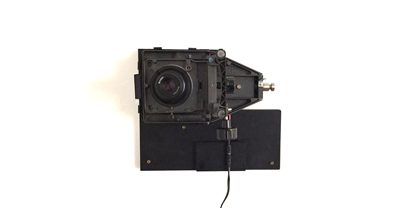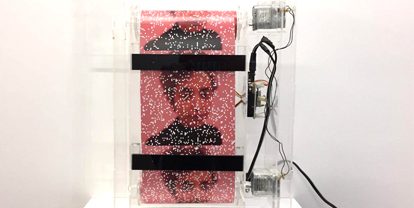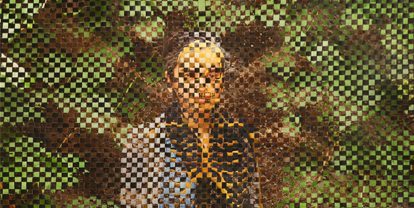Skin, Flesh, Bone
Arya Tabandehpoor
May 26 — June 14, 2017
“Skin, Flesh and Bone” are three seemingly unrelated collections by Arya Tabandehpoor that are inextricably intertwined. Although each collection is different in form but together they play a melody that is in tune. The recurrent theme of loss in his works is materialized in the new collections as well. Loss is a macrocosmic concept for the artist that encompasses death, emigration, deforestation and so forth. Death is the decay or loss of skin, flesh and bones.
“Bone” is a collection of life-size portraits of people, or their present status, woven into pictures of soil, depicting their future, death! An approach similar to Khayyam’s poetry that constantly reminds you of the pleasure of life by portraying death. “Bone” is a shredded and woven version of “life and death” by Gustav Klimt. If life is warp, death is weft, inseparable entities that create existence. If Dinh Q. Le is concerned with memories of war in his woven works, Tabandehpoor on the other hand grapples with a fundamental philosophical concept that has haunted humanity forever.
Unlike his former collections which consisted of small photographs, the artist has set foot into a new realm by creating life-size photographs in “bone”.
Loss can be elusive to people swamped with daily routines. The gradual loss we experience on a daily basis is dressed in camouflage or at times we avoid this bitter confrontation and realization by redacting the notion. “Flesh” is the embodiment of this process, decomposition. Pictures fade away in a machine rolling over and over. A process in which clarity turns into ambiguity, existence into mortality. A clear manifestation of memories melting away and friends drifting apart due to emigration. People in pictures who are in their thirties, have grey hair, the first reminder to anyone that our time here is finite.
“Skin” is the deconstruction of the medium of photography through toying with light to convey a thought. Like English artists Broomberg and Chanarin who used a roll of photographic paper and light in the frontline in Afghanistan to criticize the conflict photography, Tabandehpoor who is also concerned with war, employed a unique technique to express his reflections. “Skin” is comprised of enlargers attached to machines that move the lens back and forth. As the lens gets closer, the portrait comes in focus but some patterns of military camouflage, which are installed underneath the lens, appear on the subject’s face.
Dearth of sharp and clear-cut images, photographs in camouflage that either appear gradually or fade away before our eyes with an undertone of loss offer a unique experience of photography that is void of photography.


